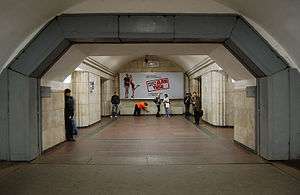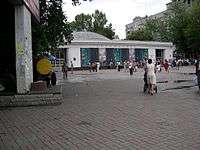Arsenalna (Kiev Metro)
Arsenalna (Ukrainian: Арсена́льна, romanized: Arsenál’na, IPA: [ɐrseˈnɑlʲnɐ]) is a station on Kyiv Metro’s Sviatoshynsko-Brovarska Line. The station was opened along with the first stage[1] and is currently the deepest station in the world (105.5 metres (346 ft)).[2][3][4] This is attributed to Kyiv’s geography where the high bank of the Dnieper River rises above the rest of the city. Also unusual is the station’s design, which lacks a central concourse and is thus similar in layout to stations on the London Underground.
Arsenalna | |||||||||||
|---|---|---|---|---|---|---|---|---|---|---|---|
 The Station Hall | |||||||||||
| Location | Pecherskyi District Kiev Ukraine | ||||||||||
| Coordinates | 50°26′40″N 30°32′44″E | ||||||||||
| Owned by | Kyiv Metro | ||||||||||
| Line(s) | |||||||||||
| Platforms | 1 | ||||||||||
| Tracks | 2 | ||||||||||
| Construction | |||||||||||
| Structure type | underground | ||||||||||
| Depth | 105.5 m (346 ft) | ||||||||||
| Platform levels | 1 | ||||||||||
| Other information | |||||||||||
| Station code | 121 | ||||||||||
| History | |||||||||||
| Opened | 6 November 1960[1] | ||||||||||
| Electrified | Yes | ||||||||||
| Services | |||||||||||
| |||||||||||
Station
Although Arsenalna (architects H. Hranatkin, S. Krushynsky, N. Shchukina) appears as a pylon trivault, the “Pylons”, along with their portals, are all purely cosmetic decorations. Pink marble walls with bronze grills (that feature metallic artwork on Soviet themes) (Soviet stars are due to be removed due to 2015 decommunization laws[5]) is all that is present in the portal. Instead the station has a small lobby which is directly connected to the escalator tunnel. The ride on the escalators itself is one of the longest totaling up to five minutes.

There are reasons for the layout of the stations, as the cosmetic pylons were planned to be real. The main one comes from the tough soils of the location and the problems with hydroisolation which forced the builders to conserve the design. Similar problems happened on the first stage in Moscow however later the stations Lubyanka and Chistye Prudy were completed. In Kyiv this never was to happen. Originally built as an interim on a long track before the line crossed the Dnieper and continued into the left bank residential districts, it was never to have a large passenger traffic to justify a complex and costly reconstruction. Nor was the station ever planned to be a transfer point (unlike the Moscow stations, which ultimately was the reason for them to be rebuilt). Thus with the Kiev Arsenal Factory, for which the station was named, being the only human source of passengers, this station is likely to remain as it is permanently.
Decoratively, apart from the spoken portals, the station is monochromatic in its appearance. The plastered vault ceilings, ceramic tiled walls and the marbled “pylons” all are of white colour. A large sculptural artwork depicting revolutionary events that took place in the Arsenal factory in 1918 graced the wall of the main lobby hall until it was removed in the early 1990s.
The station’s large surface vestibule is situated on the square leading onto Ivana Mazepy, Dmytro Godzenko, and Mykhailo Hrushevsky streets. Behind the station is a service bay that is used for nighttime stands and minor repairs to the railcar park.
References
- Kyiv Metro Subway celebrates 58th anniversary on Nov 6, UNIAN (6 November 2018)
- https://www.businessinsider.com/kiev-ukraine-soviet-era-metro-system-beautiful-deepest-world-2019-9
- https://www.amusingplanet.com/2017/03/the-deepest-metro-stations-in-world.html
- https://www.worldatlas.com/articles/deepest-metro-stations-in-the-world.html
- (in Ukrainian) From the dismantled in the Kyiv subway communist symbols will be created a museum, Zerkalo Nedeli (8 May 2016)
External links
- Kyivsky Metropoliten – Station description and Photographs (in Ukrainian)
- Zarohem.cz Archived 21 October 2007 at the Wayback Machine – Photographs (in Czech)
